Date 13.04.2017 Category:

Date 13.04.2017 Category:

Date 12.04.2017 Category:

Date 16.07.2015 Category:
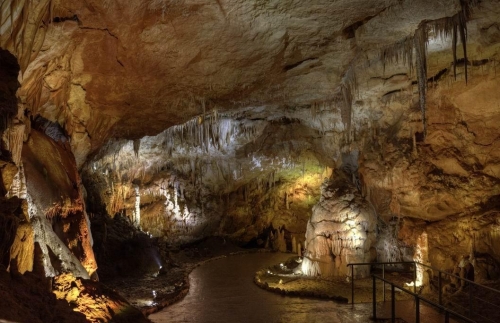
Tsqaltubo (Georgian: წყალტუბო) is a spa resort in west-central Georgia. It is located at around 42°20′23″N 42°35′57″E. It is the main town of the Tsqaltubo district of the Imereti province. It is famous for its radon-carbonatemineral springs, whose natural temperature of 33–35 °C (91–95 °F) enables the water to be used without preliminary heating.
The resort's focus is on balneotherapy for circulatory, nervous, musculo-skeletal, gynaecological and skin diseases, but since the 1970s its repertoire has included "speleotherapy", in which the cool dust-free environment of local caves is said to benefit pulmonary diseases.
Tsqaltubo was especially popular in the Soviet era, attracting around 125,000 visitors a year. Bathhouse9
Date 14.07.2015 Category:
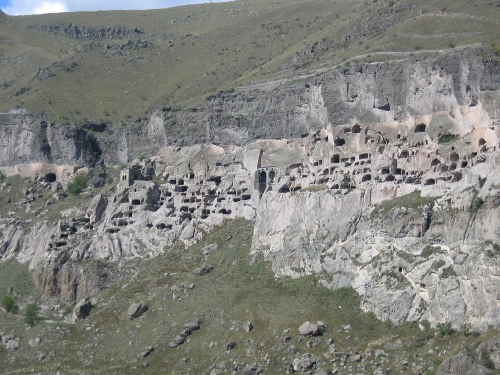
Vardzia (Georgian: ვარძია) is a cave monastery site in southern Georgia, excavated from the slopes of the Erusheti Mountain on the left bank of the Mtkvari River, thirty kilometres from Aspindza. The main period of construction was the second half of the twelfth century. The caves stretch along the cliff for some five hundred metres and in up to nineteen tiers. The Church of the Dormition, dating to the 1180s during the golden age of Tamar and Rustaveli, has an important series of wall paintings. The site was largely abandoned after the Ottoman takeover in the sixteenth century. Now part of a state heritage reserve, the extended area of Vardzia-Khertvisi has been submitted for future inscription on theUNESCO World Heritage List
The greater Vardzia area includes also the early eleventh-century churchat
Date 13.07.2015 Category:
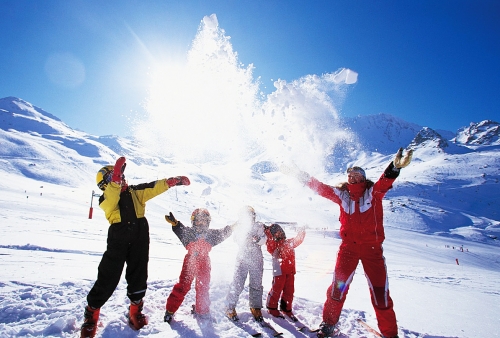
Bakuriani (Georgian: ბაკურიანი) is a skiing resort in the Borjomi district of Georgia. It is located on the northern slope of the Trialeti Range, at an elevation of 1,700 meters (5,576 feet) above sea level.
The region around Bakuriani is covered by coniferous forests (mainly made up of spruce). The resort lies 30 km (19 mi) from Borjomi and is located within the so-called Bakuriani Depression/caldera. The resort is connected with Borjomi by an electrified narrow-gauge railway. The present-day area of the town was built up by the lava flows from the Mukheri volcano. The highest mountain of the resort used for skiing is calledMount Kohta at around 2,200 meters (7,216 feet) above sea level.
The climate of Bakuriani is transitional from humid maritime to relatively humid continental. The winters are cold and experience significant snowfall while the summers are long and warm. Average annual temperature of the town is 4.3 degrees Celsius. The average temperature in Januaryis
Date 10.07.2015 Category:
.jpg)
Abastumani (Georgian: აბასთუმანი) is a small town (daba) and climatic spa in Adigeni Municipality, Samtskhe-Javakheti, Georgia. It is located on the southern slopes of the Meskheti Range (Lesser Caucasus), in the small river valley of Otskhe, 25 km northeast of Adigeni and 28 km west of Akhaltsikhe. As of the 2002 census, it had a population of 1,368.[1] The Georgian National Astrophysical Observatory is located at Abastumani.[2
In medieval Georgia, the area of modern-day Abastumani was part of the district of Odzrkhe so named after a fortress whose ruins survive near the townlet. In the 16th century, it fell to the Ottoman Empire under whose rule the area was deserted, but its hotsprings were
Date 09.07.2015 Category:
.jpg)
Borjomi (Georgian: ბორჯომი) is a resort town in south-central Georgia with a population estimated at 14,445. It is one of the districts of the Samtskhe-Javakheti region and is situated in the northwestern part of the region in the picturesqueBorjomi Gorge on the eastern edge of the Borjomi-Kharagauli National Park. The town is famous for its mineral waterindustry (which is the number one export of Georgia), the Romanov summer palace in Likani, and the World Wide Fund for Nature-site Borjomi-Kharagauli National Park. Borjomi mineral water is particularly well known in those countries which were part of the former Soviet Union; the bottling of mineral water is a major source of income for the area. Because of the supposed curative powers of the area's mineral springs, it is a frequent destination for people with health problems. Borjomi is also home to the mostextensive
Date 08.07.2015 Category:

Batumi (Georgian: ბათუმი, formerly known as Batum) is a seaside city on the Black Sea coast and capital of Adjara, an autonomous republic in southwest Georgia. With a population of 154,100,[1] Batumi serves as an important port and a commercial center. It is situated in a subtropical zone, rich in agricultural produce such as citrus fruit and tea. While industries of the city include shipbuilding, food processing, and light manufacturing, most of its economy revolves around tourism. Since 2010, the face of the city has been transformed by the construction of new high-rise landmark buildings and the renovation of the Old Town.[3]
Date 07.07.2015 Category:
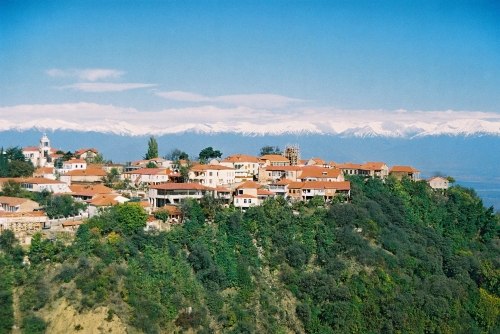
Sighnaghi (Signagi) (Georgian: სიღნაღი) is a town in Georgia's easternmost region of Kakheti and the administrative center of the Sighnaghi Municipality. It is one of the country's smallest towns with a population of 2,146 as of the 2002 census.[2] Sighnaghi's economy is dominated by the production of wine, traditional carpets and Georgian traditional food Mcvadi. The town and its environs are also known for their landscapes and historical monuments. Sighnaghi has recently undergone a fundamental reconstruction program and has become an important center of Georgia's tourist industry.
Sighnaghi and its environs are home to several historical and cultural monuments and has been specifically protected by the State since 1975. The town is walled with the remnants of 18th-century fortifications. There are two Georgian Orthodox churches in the town itself - onededicated
Date 06.07.2015 Category:
.jpg)
At over 2000 meters above sea level, Bakhmaro (Georgian: ბახმარო) in Guria region is the highest alpine climatic resort in Georgia. The average annual relative humidity is 73 per cent and the mixture of sea and mountain air is beneficial for people with respiratory problems. The surrounding mountains are a source of Bakhmaro bottled spring water, which is similar to Borjomi water in its chemical composition.
Views from the forest covered mountains are breathtaking, especially from Lenchis Seri (2505 m), which is called “Sun rise hill”. There is also a smaller Bakhmaro peak called “Sunset hill” (2250 m). When there is clear visibility it is possible to watch the sun set on the Black Sea.
Bakhmaro houses are of an unusual style. Built of wood, they are perched on columns to maximize air flow in the warm, damp climate.
Date 17.06.2015 Category:
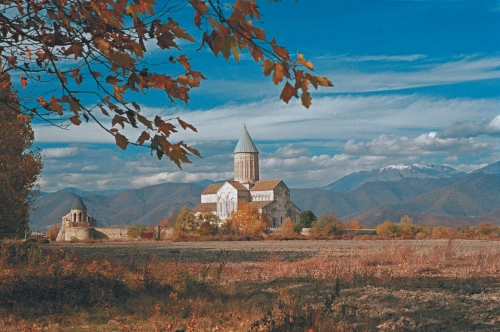
Kakheti (Georgian: კახეთი) is a region (Georgian: Mkhare) formed in the 1990s in eastern Georgia from the historical province of Kakheti and the small, mountainous province of Tusheti. Telavi is its capital. The region comprises eight administrative districts: Telavi, Gurjaani, Kvareli, Sagarejo, Dedoplistsqaro, Signagi, Lagodekhi and Akhmeta. Kakheti is bordered by the Russian Federation to the Northeast, Azerbaijan to the Southeast, and the Georgian regions ofMtskheta-Mtianeti and Kvemo Kartli to the west.
The Georgian David Gareja monastery complex is partially located in this province and is subject to a border dispute between Georgian and Azerbaijani authorities.[1]
Date 15.06.2015 Category:
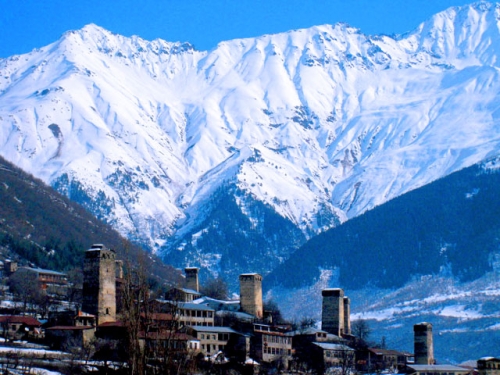
Svaneti or Svanetia (Suania in ancient sources) (Georgian: სვანეთი Svaneti) is a historic province in Georgia, in the northwestern part of the country. It is inhabited by the Svans, an ethnic subgroup of the Georgians.
Surrounded by 3,000–5,000 meter peaks, Svaneti is the highest inhabited area in the Caucasus. Four of the 10 highest peaks of the Caucasus are located in the region. The highest mountain in Georgia, Mount Shkhara at 5,201 meters (17,059 feet), is located in the province. Prominent peaks include Tetnuldi (4,974 m / 16,319 ft), Shota Rustaveli (4,960 m / 16,273 ft), Mount Ushba (4,710 m / 15,453 ft), Ailama (4,525 m / 14,842 ft), as well as Lalveri, Latsga and others.
Situated on the southern slopes of the central Greater Caucasus, Svaneti extends over the upper valleys of the Rioni,Inguri and Tskhenis-Tsqali.Geographically
Date 15.06.2015 Category:
.jpg)
The area is thought to have long been inhabited by the Tush, a subgroup of Georgians, which themselves divide into two groups- the Chaghma-Tush (Georgian name, used for Tush who speak the local Georgian dialect) and Tsova-Tush (Nakh-speaking Tush, better known as Bats or Batsbi). It is uncertain whether ethnic Georgians were there first or whether Bats were.[1] There are two major theories on the origins of the Bats (with various variations).
One is that the Bats are the remnant of a larger Nakh-speaking people. Jaimoukha speculates that they may be descended from the Kakh, a historical people living in Kakheti and Tusheti (who apparently called themselves Kabatsa).[2] However, the belief that the Kakh were originally Nakh is not widely held. The Georgian name for the Bats, the Tsova-Tush, may also (or instead) be linked to the Tsov, a historical Nakh people claimed by the Georgian historian Melikishvilli to have ruled over the Kingdom of Sophene in Urartu (called Tsobena in Georgian) who were apparentlyforcefully